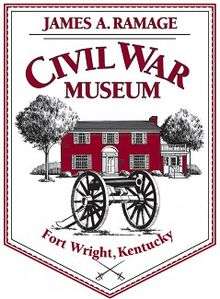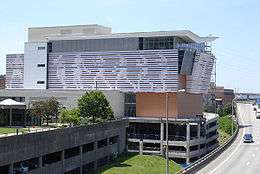James A. Ramage Civil War Museum
Coordinates: 39°03′20″N 84°31′38″W / 39.05556°N 84.52722°W
 | |
| Established | June 30, 2005 |
|---|---|
| Location | Ft. Wright, Kentucky, United States |
The James A. Ramage Civil War Museum seeks to tell the untold story of Cincinnati and Northern Kentucky's involvement in the American Civil War. Although there were no major battles set there, the people of the area resisted a strong push by the Confederate army in 1862. This museum is set on one of the key locations of that stronghold - Battery Hooper. The museum sits on 17 acres (69,000 m2) beautiful with historical passages, stories, and memorabilia. Not only does it focus on the Civil War, but it also pays homage to the Black Brigade, Fern Storer's kitchen, and the history of Fort Wright.
History
The city of Ft. Wright, Kentucky, was approached in 2004 regarding a piece of property that had recently gone on sale. The property once belonged to Fern and Sheldon Storer and was located on top of a hill that had historical significance. This hill was one of the 31 battery locations that helped fend off 6,000 of Confederate Gen. Henry Heth's soldiers in September 1862. Local men and soldiers worked together to erect an eight-mile (13 km) defensive line from Ludlow to Fort Thomas to defend against the Confederate invasion of Kentucky. Men dug rifle pits, erected forts, and cut trees for a clear field of fire using tree limbs as barriers against infantry. The Confederate soldiers marched to within a few miles of Fort Mitchel, known today as Fort Mitchell, observed for two days, and decided that the defenses - manned by 22,000 Union troops and 50,000 local militia - were too strong. The Confederate invaders withdrew into the night.[1]
The property, and more specifically the two-story house that sat on it, was also significant because it was the former home of Fern Storer. Mrs. Storer was a well-known food editor for the now defunct Cincinnati Post from 1951 to 1976. "She was meticulous about testing recipes," said [former] Cincinnati Post home/food editor Joyce Rosencrans. "She took great pride in the accuracy of those food sections and passed those principles down to me." [2]
The Museum
Fern Storer died in 2002 and bequeathed her house and 14.5 acres (59,000 m2) to the Northern Kentucky University Foundation. Rather than sell the lucrative hilltop site to developers, the NKU Foundation sold the property to the city of Fort Wright for $790,000. City officials, in turn, announced plans to turn the historic site into a passive park focusing on the area's Civil War heritage. This land is where Hooper Battery was located and is one of only six Civil War fortifications left in Northern Kentucky. The City of Fort Wright is responsible for the Battery Hooper archaeological site including public archaeology excavations and any future restoration with a $32,000 grant from the Scripps Howard Foundation Center for Civic Engagement.
In May 2004, Fort Wright Administrator Larry Klein said this of the grant, "This will be a great start to a great park. The few batteries that do exist aren't very accessible. There will be no place else like this in Greater Cincinnati that'll be preserved and open for public use."[3] Today, only six batteries remain - four in Kenton County and two in Campbell County.
The museum's namesake, Dr. James A. Ramage, is a History professor (1976–present) at Northern Kentucky University as well as a Civil War author. He's won numerous awards at NKU such as Outstanding Professor of the Year (1988), Outstanding Faculty Advisor Award (1999), and Acorn Award from Kentucky Advocates for Higher Education (2003), among others. Also, at the Phi Alpha Theta national convention in Philadelphia, January 4–6, 2006, he was elected national vice president (2006-2007) and president elect (2008-2009).
In 2004 Ramage received a University-Community Partnership Grant through NKU's Scripps Howard Center for Civil Engagement for the Battery Hooper Project. The goal was to partner with the City of Fort Wright in involving students and the public in preserving, researching, and opening Civil War Battery Hooper to the public. City Administrator Larry Klein represented the city and NKU Adjunct Professor Jeannine Kreinbrink was Archaeology Project Manager. On June 30, 2005, the project culminated with the opening of a museum on the site. Mayor Gene Weaver and the City Council named the museum in honor of Ramage's work. As of September 1, 2006, over 5,000 people had visited the James A. Ramage Civil War Museum.[4] On December 9, 2007, Douglas Vonderhaar was honored as the museum's 10,000th visitor.[5]
The Black Brigade of Cincinnati
Besides fending off a dangerous push by the Confederates, Cincinnati was the location of another noteworthy occurrence.
After the declaration of martial law on September 2, 1862, Cincinnati Mayor George Hatch ordered the police department to gather any and all able-bodied African American males for work on fatigue duty on the fortifications in Northern Kentucky. Men were driven from their homes and businesses by bayonet point to a mule pen on Plum Street in Cincinnati. After hours of solitude, the men were taken as a group across the Ohio River to begin work on the earthwork fortifications. This group became known as the Black Brigade of Cincinnati. Union General Lew Wallace learned about the poor treatment of the men. On September 4, 1862, he commissioned Judge William Martin Dickson as commander of the Black Brigade.
After receiving his appointment, Colonel Dickson changed the brigade into a working regiment. On the evening of September 4, 1862, Dickson dismissed the men to tend to their families as well as gather personal supplies for the days of work ahead. He promised them that he was forming the brigade for fatigue duty and they "should be kept together as a distinct body,... that they should receive protection and the same treatment as white men,... and that their sense of duty and honor would cause them to obey all orders given, and thus prevent the necessity of any compulsion..." In return for these promises, Dickson expected the men to meet the next morning for work on the defensive fortifications. In his official report to Ohio Governor John Brough on January 12, 1864, Dickson stated that around 400 men were present when he dismissed the brigade on September 4, 1862. The next day over 700 men reported ready for duty!
The story of the Black Brigade continues for a number of weeks as they represented the Union with pride. Because of it, Powhatan Beaty developed into a strong leader and earned a Medal of Honor on April 6, 1865. A small portion of the museum is dedicated to this occurrence and goes into much greater detail.
Events
Although the museum is an entity of the City of Fort Wright, it does accept donations in order to remain operational as well as host events of different varieties. One of the most significant and exciting events hosted is the archaeological excavations. Since the battery site has since been filled in with dirt, it was preserved quite well. This provides a fantastic opportunity for children and adults alike to work together to dig up artifacts. Other events have included, but aren't limited to, Civil War Christmas and Battery Hooper Days.
See also
- Cincinnati in the American Civil War
- Defense of Cincinnati
- Hooper Battery
- Kentucky in the American Civil War
References
- ↑ Croyle, William (2004-10-01). "Hooper Battery is being unearthed, restored". Cincinnati Enquirer. Retrieved 2008-01-17.
- ↑ "Kentucky Deaths Fern Storer". 2002-05-30. Retrieved 2008-01-17.
- ↑ Schroeder, Cindy (2004-05-04). "Civil War battery receives grant". Cincinnati Enquirer. Retrieved 2008-01-17.
- ↑ "Dr. Ramage's Homepage". Retrieved 2008-01-17.
- ↑ Schroeder, Cindy (2008-01-06). "Civil War Museum's 10,000th visitor". Cincinnati Enquirer. Retrieved 2008-01-17.



